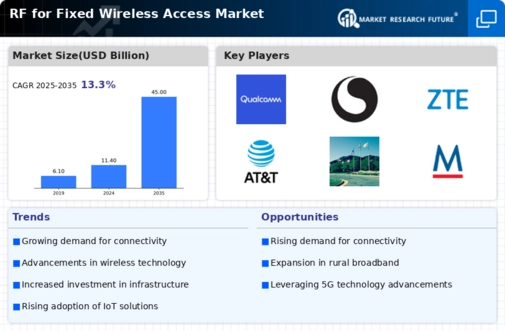Market Growth Projections
The Global RF for Fixed Wireless Access Market Industry is projected to experience substantial growth over the coming years. With a market size anticipated to reach 11.4 USD Billion in 2024 and further expand to 45 USD Billion by 2035, the industry is poised for a remarkable trajectory. The compound annual growth rate of 13.3% from 2025 to 2035 reflects the increasing demand for high-speed internet, technological advancements, and supportive government policies. This growth is indicative of the broader trends in digital transformation and connectivity, suggesting a vibrant future for fixed wireless access solutions.
Rising Adoption of IoT Devices
The rising adoption of Internet of Things (IoT) devices is a crucial driver for the Global RF for Fixed Wireless Access Market Industry. As industries increasingly integrate IoT solutions for automation and data collection, the demand for reliable and high-speed connectivity intensifies. Fixed wireless access offers a flexible and scalable solution to support the connectivity needs of numerous IoT devices, ranging from smart meters to industrial sensors. This trend is expected to contribute significantly to market growth, with the industry projected to reach 45 USD Billion by 2035. The synergy between IoT and fixed wireless access is likely to create new opportunities for service providers and technology developers.
Government Initiatives and Funding
Government initiatives aimed at expanding broadband access are pivotal to the Global RF for Fixed Wireless Access Market Industry. Various countries are implementing policies and allocating funds to improve internet connectivity, particularly in underserved areas. For instance, initiatives to bridge the digital divide often include support for fixed wireless solutions, which can be deployed more rapidly than traditional wired networks. Such governmental support not only encourages investment in RF technology but also stimulates market growth. As a result, the industry is poised for a compound annual growth rate of 13.3% from 2025 to 2035, reflecting the positive impact of these initiatives on market dynamics.
Increased Focus on Rural Connectivity
The increased focus on rural connectivity is shaping the Global RF for Fixed Wireless Access Market Industry. Many regions still lack adequate broadband infrastructure, leading to a push for solutions that can deliver high-speed internet to rural and remote areas. Fixed wireless access is particularly advantageous in these contexts, as it can be deployed quickly and cost-effectively compared to traditional wired solutions. This growing emphasis on rural connectivity aligns with government initiatives and private sector investments aimed at enhancing digital inclusion. As a result, the market is expected to experience robust growth, with projections indicating a compound annual growth rate of 13.3% from 2025 to 2035.
Growing Demand for High-Speed Internet
The increasing demand for high-speed internet connectivity is a primary driver of the Global RF for Fixed Wireless Access Market Industry. As more consumers and businesses seek reliable and fast internet services, the market is projected to reach 11.4 USD Billion in 2024. This demand is fueled by the proliferation of smart devices and the need for seamless connectivity in urban and rural areas alike. Fixed wireless access provides a viable solution, particularly in regions where traditional wired infrastructure is lacking or economically unfeasible. The emphasis on digital transformation across various sectors further amplifies this trend, indicating a robust growth trajectory for the industry.
Technological Advancements in RF Technology
Technological advancements in radio frequency technology are significantly influencing the Global RF for Fixed Wireless Access Market Industry. Innovations such as beamforming, MIMO (Multiple Input Multiple Output), and advanced modulation techniques enhance the efficiency and capacity of wireless networks. These developments enable service providers to deliver higher data rates and improved coverage, making fixed wireless access an attractive alternative to traditional broadband solutions. As these technologies evolve, they are expected to drive market growth, with projections indicating a market size of 45 USD Billion by 2035. The continuous enhancement of RF technology is likely to foster increased adoption among consumers and enterprises.











